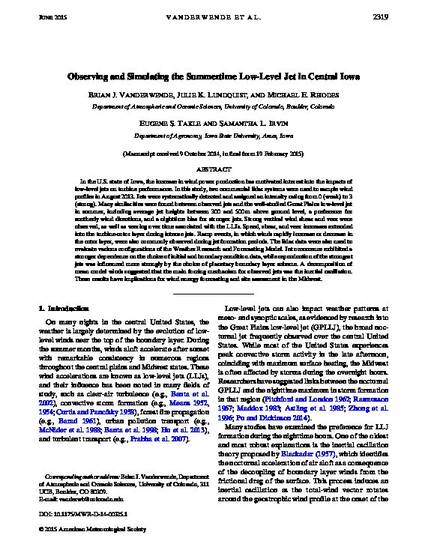Publication Version
Published Version
Publication Date
5-1-2015
DOI
10.1175/MWR-D-14-00325.1
Abstract
In the U.S. state of Iowa, the increase in wind power production has motivated interest into the impacts of low-level jets on turbine performance. In this study, two commercial lidar systems were used to sample wind profiles in August 2013. Jets were systematically detected and assigned an intensity rating from 0 (weak) to 3 (strong). Many similarities were found between observed jets and the well-studied Great Plains low-level jet in summer, including average jet heights between 300 and 500 m above ground level, a preference for southerly wind directions, and a nighttime bias for stronger jets. Strong vertical wind shear and veer were observed, as well as veering over time associated with the LLJs. Speed, shear, and veer increases extended into the turbine-rotor layer during intense jets. Ramp events, in which winds rapidly increase or decrease in the rotor layer, were also commonly observed during jet formation periods. The lidar data were also used to evaluate various configurations of the Weather Research and Forecasting Model. Jet occurrence exhibited a stronger dependence on the choice of initial and boundary condition data, while reproduction of the strongest jets was influenced more strongly by the choice of planetary boundary layer scheme. A decomposition of mean model winds suggested that the main forcing mechanism for observed jets was the inertial oscillation. These results have implications for wind energy forecasting and site assessment in the Midwest.
Rights
© Copyright 2015 American Meteorological Society (AMS). Permission to use figures, tables, and brief excerpts from this work in scientific and educational works is hereby granted provided that the source is acknowledged. Any use of material in this work that is determined to be “fair use” under Section 107 of the U.S. Copyright Act September 2010 Page 2 or that satisfies the conditions specified in Section 108 of the U.S. Copyright Act (17 USC §108, as revised by P.L. 94-553) does not require the AMS’s permission. Republication, systematic reproduction, posting in electronic form, such as on a website or in a searchable database, or other uses of this material, except as exempted by the above statement, requires written permission or a license from the AMS. All AMS journals and monograph publications are registered with the Copyright Clearance Center (http://www.copyright.com). Questions about permission to use materials for which AMS holds the copyright can also be directed to the AMS Permissions Officer at permissions@ametsoc.org. Additional details are provided in the AMS Copyright Policy statement, available on the AMS website (http://www.ametsoc.org/CopyrightInformation).
Copyright Owner
American Meteorological Society
Citation Information
Brian J. Vanderwende, Julie K. Lundquist, Michael E. Rhodes, Eugene S. Takle, et al.. "Observing and Simulating the Summertime Low-Level Jet in Central Iowa"
Monthly Weather Review Vol. 143 Iss. 6 (2015) p. 2319 - 2336
Available at: http://works.bepress.com/eugene-takle/48/


This article is from Monthly Weather Review 143 (2015): 2319, doi:10.1175/MWR-D-14-00325.1. Posted with permission.